Ciervo de los pantanos Overview
Ciervo de los Pantanos National Park, known locally as Parque Nacional Ciervo de los Pantanos, is a protected natural area in Argentina, covering approximately 204 square miles (528 square kilometers).
Located in the Buenos Aires Province, near the city of Campana, this park safeguards a diverse wetland ecosystem within the Paraná Delta. The region is characterized by marshlands, lagoons, grasslands, and riparian forests, providing a unique landscape that supports an array of wildlife and vegetation.
The park’s wetlands, shaped by the meandering waterways of the Paraná River, are interspersed with native tree species like the curupí and willows, along with floating vegetation that thrives in the slow-moving waters.
The park is named after its most iconic resident, the marsh deer, a large and vulnerable species that relies on the protected wetlands for survival. Other notable mammals found in the park include capybaras, neotropical otters, and crab-eating foxes.
The rich birdlife makes it a key site for birdwatching, with species such as the long-winged harrier, black-necked swan, and the striking scarlet-headed blackbird. Reptiles and amphibians, including broad-snouted caimans and several species of frogs, further add to the biodiversity of the region.
Visitors to Ciervo de los Pantanos National Park can explore the area through its network of trails and waterways. Hiking paths allow for close encounters with the diverse flora and fauna, while guided boat tours offer a unique perspective of the wetlands, revealing the beauty of the submerged forests and open lagoons.
Wildlife observation points and birdwatching stations are placed strategically within the park, enhancing the experience for nature enthusiasts. Kayaking and canoeing are also popular activities, allowing for an immersive journey through the park’s waterways.
The park faces several conservation challenges, including habitat loss due to agricultural expansion and urban development in surrounding areas. Pollution from industrial and agricultural activities threatens water quality, impacting both wildlife and plant species.
However, conservation efforts, such as habitat restoration and environmental education programs, have been successful in raising awareness and improving ecological conditions within the park. The protection of the marsh deer and other vulnerable species remains a key focus of management strategies, ensuring the long-term survival of this valuable wetland ecosystem.


















































































